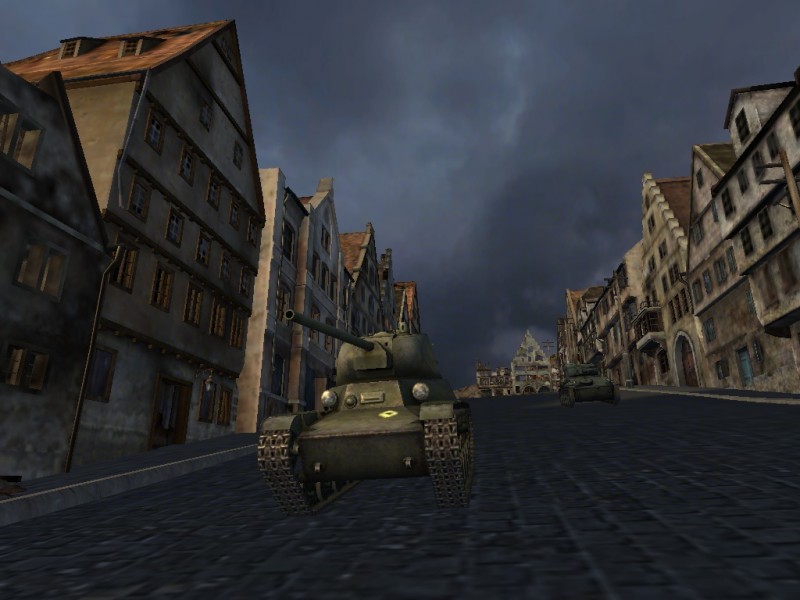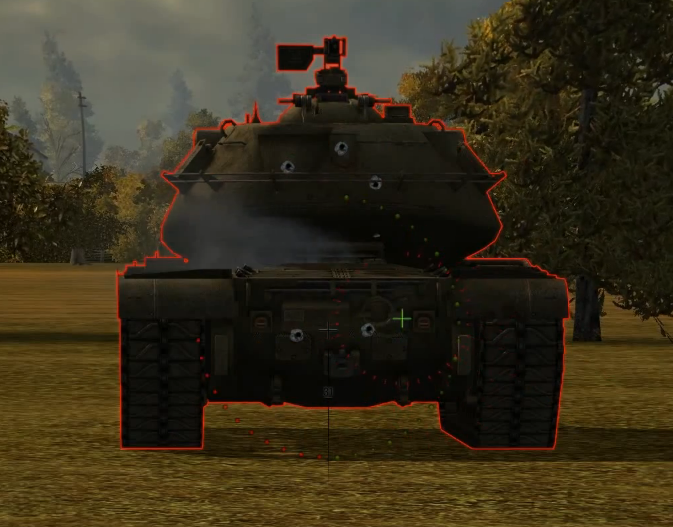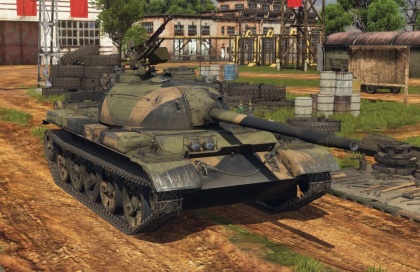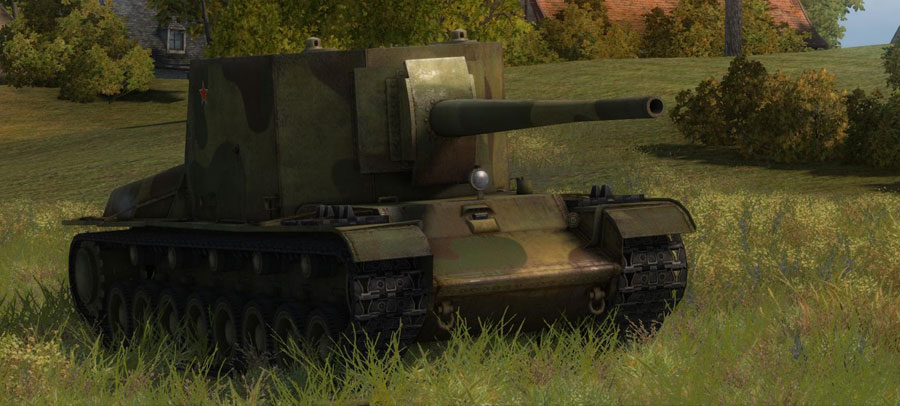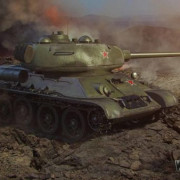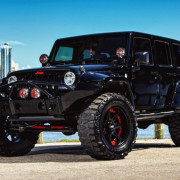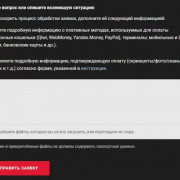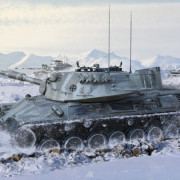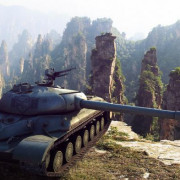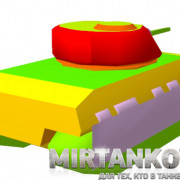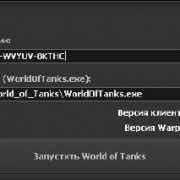M26 pershing
Содержание:
T20 prototype (1942)
Development of the T20 Medium Tank started as an upgrade over the M4 in 1942. This new tank had common features with earlier models, notably the characteristic suspension (HVSS) bogies, roadwheels, return rollers, drive sprockets and idlers. By May 1942, a mock-up of the T20 had been already produced. U.S. Army Ordnance also ordered the development of the M6 heavy tank, which would prove a dead end. The main feature of the T20 was the lower silhouette and more compact hull, allowed by the availability of the new Ford GAN V-8 combined with a rear transmission and rear sprocket drive layout.
This engine was an early attempt to produce a V12 with similar layout and performances to the Rolls Royce Merlin, but development was stopped and the engine was turned into a smaller V8. Other improvements included a sturdier horizontal volute spring suspension (HVSS), a longer barrel version of the 75 mm (2.95 in) (M1A1), and 76.2 mm (3 in) front armor. The weight and width were very similar to the M4, allowing transportation in similar conditions. However, the T20 also pioneered the Torqmatic transmission, which proved highly problematic during trials.
Production and controversy
It is a known fact that the actual production of the T26E3 preseries, which was standardized in March as the M26, only began in November 1944 at the Fischer Tank Arsenal. Only ten were built this first month. Then it raised to 32 in December and gained momentum in January 1945, with 70 vehicles and 132 in February. Added to this, the Detroit Tank Arsenal also joined this effort, releasing some additional tanks in March 1945. From then, around 200 left both factories each month. In total about 2212 vehicles were built, some after WW2. Although months were needed to train crews and maintenance teams, the first real operations began in western Germany in February-March 1945.
The controversy came with the legitimate question about the well-documented inefficiency of the M4 Sherman against German armor after 1944, correlated with the fact that the US Army failed to field a new tank model in time, since the T26 was delayed for so long. Several historians, like Richard P. Hunnicut, Georges Forty and Steven S. Zaloga specifically pointed to the responsibility of the ground forces head, General Lesley McNair, in this matter of fact. Depending on the these opinions, several factors contributed to these delays:
-The development of tank destroyers alongside regular M4s and based on the same chassis (McNair himself developed and strongly supported this doctrine) or the introduction of improved M4s (the 1944 “76” versions).
-The need to have a streamlined and simplified line of supply. Most US tanks at that time were M4s or based on the M4 chassis, sharing the same components. Adding to this a brand new set of parts and a heavier, untested tank, would have imposed many changes and perhaps jeopardized such 3000 miles long (4800 km) supply lines, which became essential from D-Day on.
-A state of complacency after the introduction of the M4, as it was seen as superior to German tanks in 1942 and still a match in 1943. Many officers, including Patton himself, were quite happy with the high mobility and reliability of this model, and opposed the introduction of a new heavy type, which was seen as unnecessary. Even when the Tiger and Panther were encountered in limited numbers, the order to study a new model was not given, and instead time was “wasted” on studying a new electric transmission. Only after Normandy were some efforts made to develop a new tank from the T25.
-From Zaloga’s point of view, there was a clear opposition to the development of the T26, only lifted when General Marshall, supported by Eisenhower, overruled McNair in December 1943 and renewed the project, although it proceeded quite slowly. Hunnicut underlines the ordnance requested 500 vehicles of each model in development then, the T23, T25E1 and T26E1, because of contradictory wishes. The Army Ground Forces systematically objected to the 90 mm (3.54 in) armed new heavy tank, while the Armored Forces branch wanted the 90 mm (3.54 in) to be mounted on the Sherman.
Active service
Europe
The Army Ground Forces wanted to delay full production until the new T26E3 was battle-proven. So the Zebra Mission was mounted by the Armored Forces Research and Development unit, led by General Gladeon Barnes in January 1945. Twenty vehicles of the first batch were sent in Western Europe, landing at the Belgian port of Antwerp. They would be the only Pershings to see combat in World War Two, spread between the 3rd and 9th Armored Divisions, part of the First Army, although some 310 would be shipped to Europe until V-day. They drew their first blood in late February 1945 in the Roer river sector. A famous duel took place in March at Köln (Cologne). Four T26E3s were also seen in action during the “mad dash” to the bridge at Remagen, providing support, but not crossing the fragile bridge for days. Instead, these heavyweights crossed the Rhine on barges.
After the war, M26s were grouped into the 1st Infantry Division, stationed in Europe as a reserve, following the events of the summer of 1947. The “Big Red One” counted 123 M26s in three regimental and one divisional tank battalions. In the summer of 1951, with the NATO reinforcement program, three more infantry divisions were stationed in West Germany, and accepted mostly battle-proven M26s retired from Korea. However, by 1952-53, these were phased out gradually in favor of the M47 Patton.The Belgian army inherited the bulk of these, including many reconditioned M26A1s from USA, for a total of 423 Pershings, leased for free as part of the Mutual Defence Assistance Program. These served in three Régiments de Guides, three Régiments de Lanciers and three Batallions de Chars Lourds. These were also phased out and replaced by the M47 Patton, only two units retaining them by 1961. They were retired from service in 1969. By 1952-53, France and Italy also benefited from the same program and were given M26s. France swapped them soon after for M47s, while Italy retained them operationally until 1963.
The Pacific
While the heavy fighting at Okinawa raised concerns about the losses taken by M4s, it was eventually decided to send a shipment of 12 M26s, departing on May, 31. They landed at Naha beach on the 4th of August. However, they arrived too late as the island was nearly secured.
Korea
The bulk of the M26 (and M26A1) force saw action during the Korean war, from 1950 to 1953. The first units to be called were the four infantry division stationed in Japan, only counting a few M24 Chaffees and howitzer support models. The M24s were quickly found no match for the numerous T-34/85s fielded then by the North Koreans. However, three M26s were found in storage at the Tokyo US Army ordnance depot, and were quickly brought back in service with fortune-made fanbelts. They were formed into a provisional tank platoon by Lieutnant Samuel Fowler. They were deployed in mid-July, first seeing action when defending Chinju. However, their engines overheated and died out in the process. By the end of July 1950, more divisions were sent, but still counting mostly medium tanks, M4s of the latest types. Many M26s were hastily reconditioned and shipped. By the end of the year, some 305 Pershings managed to arrive in Korea.
After November 1950, however, most of the tank to tank battles were already spent, and North Korean T-34s became rarer. A 1954 survey showed that the M4A3s scored the highest kills (50% because of their large availability), followed by the Pershing (32%) and the M46 (only 10%). However, the kill/loss ratio was clearly favorable to the second and especially for the third, as the M26 found no difficulty getting through the T-34s armor at any ranges, well helped by the largely available HVAP ammunition, while its armor stood well against the T-34’s 85 mm (3.35 in) gun. In February 1951, Chinese forces deployed considerable numbers of T-34/85s, but these were widely spread between infantry divisions for close support. The same year the M46 Patton, the upgraded version of the M26, gradually replaced the Pershing, as it was found unable to display sufficient mobility on the mountainous terrain of Korea.
The T25 and T26
The T25 was a new design, up-armored and up-gunned. This was done as it was clear, after the first encounters with German upgraded Panzer IVs, Panthers and Tigers, that the M4 was less up to the task than previously thought. The debate was heated, but finally, a breach opened and clear-cut decisions were taken after the reports came from Normandy. Meanwhile, a series of T25s was built, inaugurating a new, far larger cast turret derived from the one on the T23, in order to accommodate a 90 mm (3.54 in) gun.
The T26 added upgraded armor to the mix, with a new 102 mm (4 in) thick glacis and reinforced hull. Their overall weight rose to 36 tonnes (40 short tons), up into the category of “heavy tanks”.
Performance decreased, and triggered reliability and maintenance issues, as their engine and transmission were not designed to cope with the additional stress. The T25 displayed VVSS suspensions while the T26 used the final torsion bar system retained on the M26. The T26E1 was the prototype upon which the upgraded production version T26E3 was based on. After a small pre-series, this was standardized as the M26.
Starting a dynasty: The Patton series (1947-1960)
Too late for World War Two, but also not mobile enough for Korea, produced in small quantities related to other models from the same time frame, the Pershing seemed to have been a stopgap model, bound for history’s dark corners. However, it technically started a brand new generation of US Cold War tanks, sharing the same revolutionary suspension system, roomy turret and low-profile hull, better known collectively as the “Pattons”. A dynasty which lasted well into the 90s, when the last modernized M60s in service came to retirement. Many are still found in frontline units all around the world.
(Illustration lost: T26E1.png)T25 prototype number 2, mid-1944. This was basically an upgraded T23E3 with HVSS suspensions, new 90 mm (3.54 in) gun and cast turret.

T26 prototype, mid-1944. The biggest changes were the new armor and new wheeltrain.
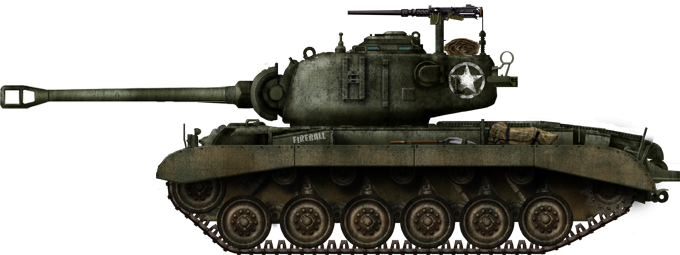 T26E3, named “Fireball”, with the 3rd Armored Division. It fought in the Ruhr river sector, was engaged and hit three times by a concealed Tiger on 25 February 1945, at Elsdorf. The Tiger was then discovered, tried to back away to escape, but ran into debris and was immobilized. It was eventually abandoned by its crew. The M26 was later salvaged, repaired, and returned to combat. Another one of the same company later engaged and destroyed a Tiger and two Panzer IVs.
T26E3, named “Fireball”, with the 3rd Armored Division. It fought in the Ruhr river sector, was engaged and hit three times by a concealed Tiger on 25 February 1945, at Elsdorf. The Tiger was then discovered, tried to back away to escape, but ran into debris and was immobilized. It was eventually abandoned by its crew. The M26 was later salvaged, repaired, and returned to combat. Another one of the same company later engaged and destroyed a Tiger and two Panzer IVs.
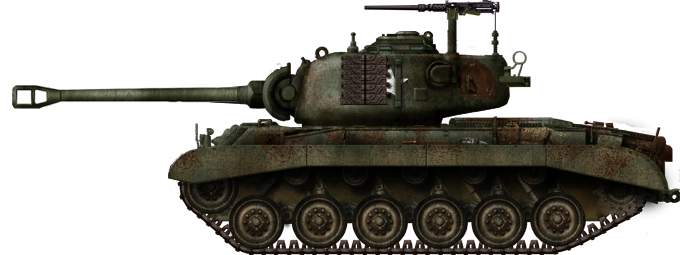
Camouflaged T26E3 in Germany, May 1945. The pattern is purely fictional, as there is no clear evidence of them being camouflaged.
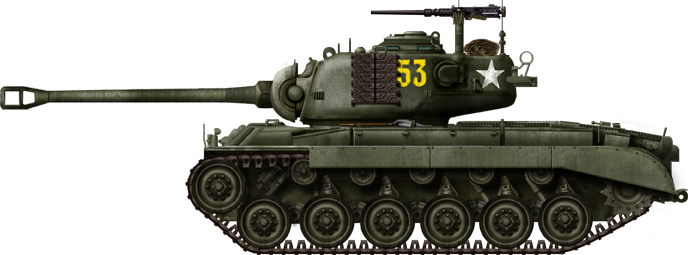
M26 of A Company, 1st USMC Battalion, Korea 1950.
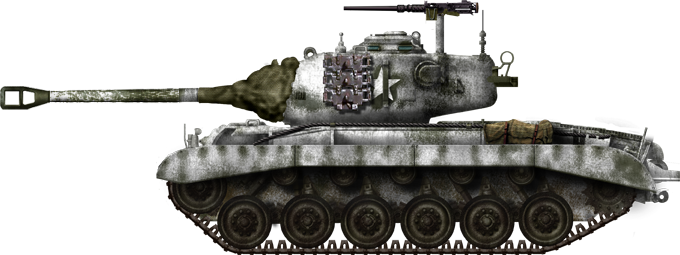
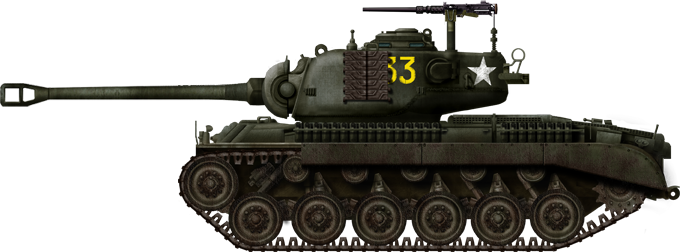
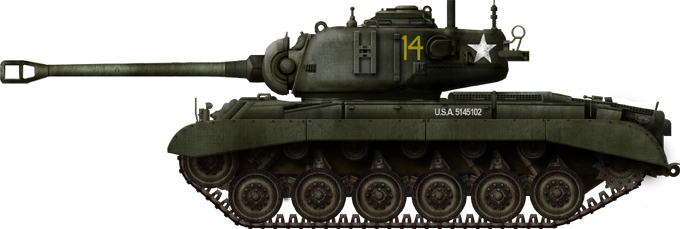
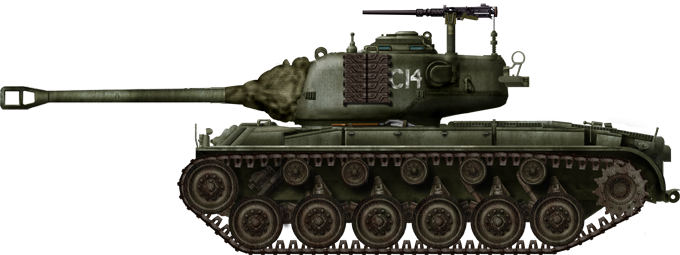
M26 of C Company, 1st Marine Tank Battalion, Pohang, January 1951.
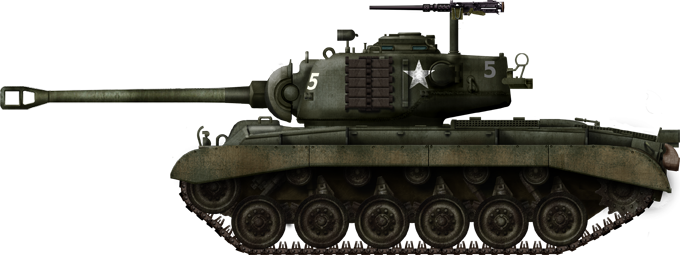
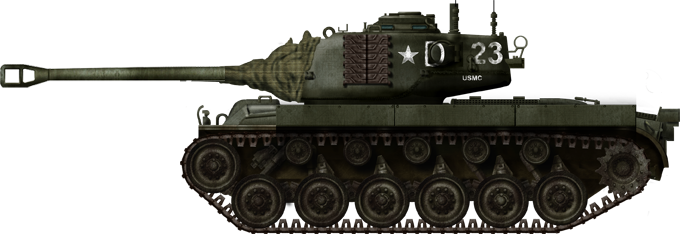
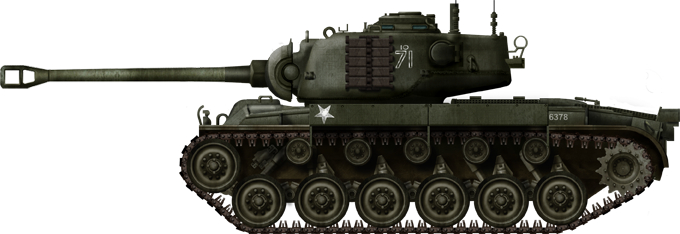
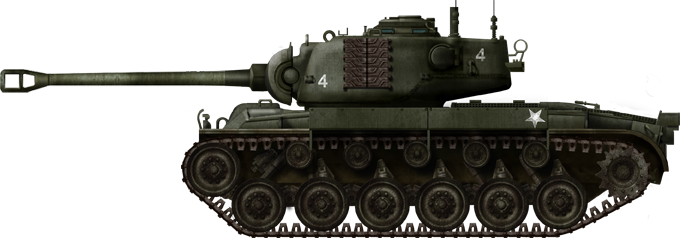
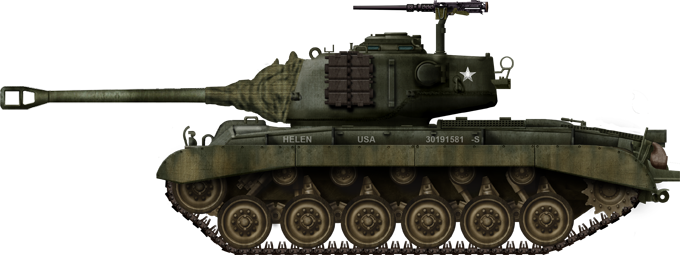
M26A1, Korea, summer 1950.
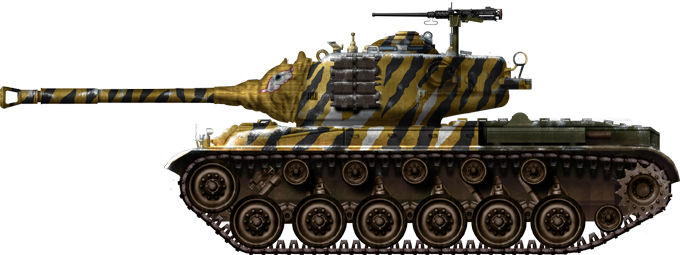
Модификации
- M26 (T26E3) — Вооружен M3 с двойной перегородкой дульного тормоза. Основная производственная модель;
- M45 (Т26Е2) — Танки перевооруженные 105мм гаубицей М4;
- M26A1 — М26 перевооруженный орудием M3A1 получившим эжектор;
«Супер Першинг» на испытаниях в Европе.
- T26E1-1 — Тестовый экземпляр на базе танка Т26Е1 с орудием T15E1 обладающим унитарным заряжанием и внешним пружинным стабилизатором орудия, проходил испытание в Европе где получил дополнительно бронирование и прозвище «Супер Першинг»;
- T26E4 — Модель вооруженная орудием T15E2 с раздельно-гильзовым заряжанием, так же были учтены все проблемы возникшие с новым орудием на танке Т26Е1-1, установлены новые пружинные балансиры спрятанные под башню, предусматривался крупносерийный выпуск, однако в следствии окончания войны выпущен малой серией в 25 машин;
- M26E1 — Два танка вооруженные длинноствольным орудием Т54 с унитарным заряжанием и отличительным грушевидным дульным тормозом, создавались как решение проблемы возникшее на танках Т26Е1-1 и Т26Е4 где в следствии установки нового орудия и новых удлиненных снарядов к ним значительно сократился внутренний объем что усложняло работу экипажу, итогом работ стало освобождение части пространства изменением казенной части и гильзы снарядов, длину которой сократили путем увеличения диаметра, благодаря чему баллистические характеристики орудия Т54 соответствовали Т15;
- M26E2 — Новый более мощный двигатель и коробка передач, в следствии проблем с надежностью нового двигателя в серию не пошел, однако послужил основой для создания танка Т40 позже стандартизированного как М46 Паттон;
- T26E5 — Версия М26 с увеличенным бронированием до 150мм во лбу корпуса и 180 лба башни, был выпущен малой серией в 27 машин;
A bit late for WWII
The M26 Pershing descended from a long series of medium and heavy tank prototypes, dating back from 1936. During the war, heavy tank development had been long delayed or given low priority since the US Army, USMC and Allied forces required a mass-built, good-all-around medium tank, which took the shape of the Medium M4 Sherman.
By 1944, the High Command was aware of the limitation of the M4 when facing German tanks. By mid-1944, both the British and US had undertaken upgrades in armor and guns on the Sherman, and developed tank-hunters instead of mass-producing a brand new model. However, by the fall of 1944, these stopgap measures proved insufficient, and the innovative M26 was eventually pushed forward for production. But it was a bit too late. The Pershing saw little combat and mostly soldiered during the Cold War, starting with Korea. At last, the crews had the ideal tank to deal with German armor, but historians and authors still debate about the causes of such delays. Could the Pershing have been a game changer if introduced earlier?
Боевое применение
Вторая мировая война
M26 долгое время находился в разработке, поэтому попал на войну в самом её конце. Небольшое количество этих танков было передано в 12-ю армейскую группу генерала Омара Брэдли и распределено между 3-й и 9-й танковыми дивизиями. Первый бой танки приняли в феврале 1945 года. Первая зафиксированная потеря танка «Першинг» произошла 28 февраля — один танк был подбит немецким «Тигром», но позже был отремонтирован.
Белтон Купер, во время войны — офицер службы вооружений в боевом командовании 3-й танковой дивизии, вспоминает о «Першингах» в книге своих мемуаров. По его словам, десять танков «Першинг» прибыли в 3-ю танковую дивизию в начале февраля 1945 года. Купер утверждает, что эти танки могли бы поступить туда раньше, если бы не противодействие со стороны генерала Джорджа Паттона, который предпочитал танки «Шерман». Своё предпочтение Паттон объяснял тем, что «Шерман» потребляет меньше топлива и имеет лучшие ходовые качества, чем «Першинг». На то время, к которому относятся возражения Паттона, относительная слабость вооружения «Шермана» и недостаточная его броневая защита ещё не были столь очевидными.
Война в Корее
Трофейный M26, захваченный северокорейцами во время войны в Корее
Северокорейские танки Т-34-85, подбитые M26 «Першинг»
Танки «Першинг» также участвовали в войне в Корее, хотя туда было послано относительно небольшое количество танков, так как командиры докладывали с фронта: «Корея — страна, не очень пригодная для танков». Официальная история армии США утверждает даже, что некоторые из танков «Першинг» были ради этого сняты с пьедесталов в Форт-Ноксе, где они к тому времени служили мемориалами Второй мировой войны. Всего с 10 августа 1950 года по 10 января 1951 было отправлено 309 танков «Першинг». В ходе войны танки M26 уничтожили 29 северокорейских Т-34-85. По американским данным, северокорейским «тридцатьчетвёркам» удалось подбить 6 «Першингов». С июля 1950 года по 21 января 1951 в составе 1-го, 9-го и 10-го армейских корпусов было задействовано 252 танка «Першинг», из которых 156 танков было выведено из строя, в том числе 50 танков было полностью уничтожено или захвачено. С 21 января по 6 октября 1951 года было выведено из строя 170 танков M26, безвозвратная часть неизвестна. В последующий период потери неизвестны.
На «Першинге» совершил свой подвиг экипаж сержанта Э. Коумы, уничтоживший в продолжавшемся 9 часов бою свыше 250 северокорейских солдат.
В связи с низкой эффективностью применения в горных условиях (двигатель 500 л.с. как и на 30-тонном ) в 1951 году все «Першинги» были заменены «Шерманами» и «Паттонами».
Примечания
- R. P. Hunnicutt. Firepower: A History of the American Heavy Tank. — P. 70.
- Official munitions production of the united states. By months, july 1, 1940 — august 31, 1945. Civilian production administration may 1, 1947.
- Official munitions production of the united states. By months, july 1, 1940 — august 31, 1945. Civilian production administration may 1, 1947.
- T-34-85 Vs M26 Pershing: Korea 1950. Steven Zaloga. P. 77.
- «M26/M46 Pershing Tank 1943–1953». Steven Zaloga. 2000. стр. 36-40
- US Armor in the antitank role, Korea, 1950. A.D. Coox.
- Employment of armor in Korea. Vol.1. General Military History
- Employment of armor in Korea. Vol.2. General Military History
- «US Army Forces in the Korean War 1950–53», Donald Boose, Jr. 2005. стр.75-81
